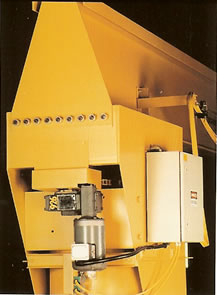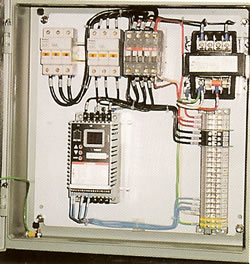| FEATURES
OF MOTORIZED CONTROL PACKAGE |
|
|
|
|
|
|
|
 |
|
|
•
Variable Frequency Drive (VFD) is standard. |
|
|
|
The
Variable Frequency Drive can be used in single or multiple speed
applications. |
|
|
|
|
|
|
|
|
•
Variable Frequency Drive provides the ultimate in load control. |
|
|
|
The
VFD provides the ultimate in load control and positioning from the
slowest possible creep speed up to maximum speed. The VFD is up to
25 times smoother than ballast resistor controls, does not produce
extensive heat, and enables precise starting and stopping. |
|
|
|
|
|
|
|
|
•
Easily adjustable speed control. |
|
|
|
Through
a simple keypad on the VFD, the acceleration rate,
deceleration rate and rotation speed can be adjusted to fit your application.
This allows you to customize the performance of the jib to your exact
requirements. |
|
|
|
|
|
|
|
|
•
Designed for indoor and outdoor use. |
|
|
|
When
being used outdoors, the cranes are designed to operate in
winds of 15 mph or less, based on a maximum load surface of 16 square
feet. Consult us for applications exceeding these standards. |
The
direct drive powers the rotation
of the Free Standing Crane. A speed
of 1/2 RPM is standard. |
|
|
|
|
|
|
|
|
•
Standard NEMA 4X Controls Enclosure. |
|
|
|
 |
|
|
Standard
controls enclosure meets the requirements for NEMA 3R,
12, 4 and 4X environments. Optional enclosures are available for other
environments. |
|
|
|
|
|
|
•
Low maintenance costs. |
|
|
The
VFD eliminates the need for magnetic reversing contractors,
reduces the number of wearable components in the panel, and reduces
long-term maintenance costs. |
|
|
|
|
|
|
|
Add
$18,775.00 to price of manual jibs shown in capacity pages. |
|
|
|
|
|
|
|
Pricing
and Dimensional Specifications -
Click a Load Capacity Link Here |
|
|
|
|
|
|
Variable
Speed Controls provide the
ultimate in jib crane rotation control form
creep speed to maximum speed. |
|
|
|
|
|
|